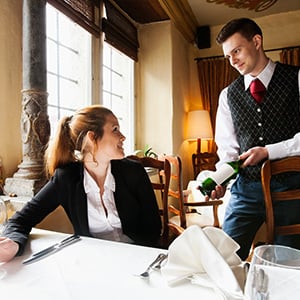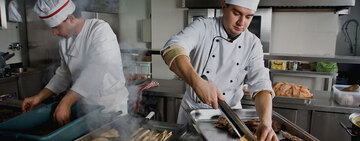Guidelines for Training Restaurant Servers
Regardless of a restaurant's size or style, the serving staff represents the face of every dining establishment. These individuals will interact the most with your customers during a visit, and positive interactions can go a long way towards ensuring those same patrons return. Hiring the right employees for the job from the start is always ideal, but the introduction of a structured server training program can pay huge dividends for your business. The following guidelines for restaurant server training will help establish an effective, knowledgeable staff and should remain as focal teaching points for all employees.
1. Etiquette

These days, restaurant servers are required to perform more than just "service with a smile." Proper etiquette includes serving female guests first, exhibiting an appropriate posture, and refraining from eating or drinking while in front of guests. These particular tips are touched on in our Fine Dining Etiquette for Servers article, but by no means does the list stop there.
An ideal server will be social and engaging as well as polite and approachable. While it may be difficult to "teach" the best social skills, your servers should nonetheless be encouraged to make customers feel welcome. Guests are looking for a wait staff with a positive attitude, cheery disposition, and willingness to accommodate any request from the start of the meal to the very end.
An exceptional server is great at reading a customer's personality. Sometimes, this means being able to recite the entirety of the menu, specials, wine list, etc., and other times the guests are looking for romantic, undisturbed service. It's the server's job to discern this and act accordingly.
For the purpose of waiter training, be sure to give new employees the chance to practice their technique through the use of role-playing exercises. With this method, a variety of common interactions can be touched on, all within the span of just a few minutes. In addition, this method can prepare new staff members with the proper responses to complaints or upset customers.
2. Appearance
A sloppy uniform can serve as a red flag for any number of new guests. The presence of stains, wrinkles, or creases suggests a disregard for professional appearance. Encourage your staff members to be mindful of their server outfits at all times. It also helps to have extra, clean uniforms available in the event of an improper uniform that needs to be changed.
Try to clearly define all appearance standards and expectations when new employees begin working. This includes their uniforms, hair, jewelry, facial piercings, and finger nails as well. These details are small, but will be a large focus for any waitress training program. Make it a priority to discuss these things at length during server training, and make the dress code requirements readily available within an employee handbook.
3. Knowledge of Menu

Just as important as appearance and etiquette is a working knowledge of the restaurant and its food offerings. Even the most descriptive of menus still require clarification from time to time, and your wait staff should be as familiar as possible with the menu. The best serving staff should be able to not only explain in detail each menu item, but also provide suggestions, recite any daily specials with ease, and answer a customer's questions.
Prepping your new staff with this vital knowledge may seem like a daunting task, but it can actually lend itself to some fun and easy memorization games during restaurant server training. For example, the more experienced employees can quiz others on key items and their respective ingredients. Challenge your new employees to take time memorizing and reading on their own as well, and in the event of a customer question they cannot answer, ensure that they know who to ask at any given time in order to get an answer.
4. Knowledge of Restaurant Layout
Customer satisfaction can depend largely on two things—taste and efficiency. The latter is difficult to accomplish if your servers remain unaware of the fastest routes to and from the kitchen, in addition to other important stops such as storage rooms, restrooms, and the emergency exits. During waiter or waitress training, be sure to identify key routes to the most important parts of the facility. Additionally, your staff will always want to be aware of the surroundings, so point out potential problem areas as well. This can include high traffic locations or places which could contain one or two "blind spots" for servers carrying full trays of food.
5. Knowledge of Restaurant Vision

Your restaurant concept and history are important, and will typically remain a large part of day-to-day operations. Make sure your employees recognize this and can speak to the restaurant's background, notable characteristics, or even historical accomplishments. An effective server training program will cover each of these details. If the concept is unique enough that it brought new customers to your location in the first place, make sure your wait staff has that ability to answer questions and even provide more details and information.
6. Ongoing Training
Several of these guidelines, such as your restaurant layout and the menu, may change over time, so it's important to use all of these teaching points as part of ongoing training sessions for all your servers. By implementing an ongoing training program, you have the opportunity to increase productivity, update policies to comply with new industry regulations, and improve job satisfaction in a work area that's often high in employee turnover. Some specific things to make part of long-term training include:
- Learning which menu items are most popular, least expensive, most expensive, etc.
- Acquiring knowledge of weekly or daily specials
- Successfully selling guests on appetizers or desserts
- Finding the right balance between too much and too little interaction with guests at their table
- Improving awareness and multi-tasking skills
- Reading personalities/attitudes and determining exactly which kind of service the guest desires
Single-event training can often be forgetten or seem overwhelming for a new employee on the first day. Ongoing training allows for employers to evaluate and follow-up effectively in order to get the most out of their staff. This type of restaurant server training can help propel your operation to the next level of professional, award-winning service.

Ad

Related Resources










































No comments:
Post a Comment